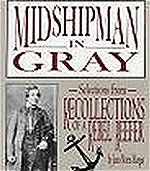Confederate boat expedition led by Commander J. T. Wood captured and destroyed USS Underwriter in the Neuse River, North Carolina.
17 February
Confederate submarine H. L. Hunley sank Union blockader Housatonic off Charleston -- the first submarine to sink a ship in combat.
12 March
Ships of Rear Admiral D. D. Porter's Mississippi Squadron moved up the Red River to commence the unsuccessful Army-Navy campaign to gain a foothold in the Texas interior.
19 April
CSS Albemarle , Commander J. W. Cooke, sank USS Southfield and forced the remainder of the Union squadron at Plymouth, North Carolina, to withdraw. Having gained control of the waterways in the area, the Confederates were able to capture Plymouth on 20 April.
5 May
USS Sassacus, Wyalusing , and Mattabesett engaged CSS Albemarle off the mouth of the Roanoke River as the Union sought in vain to regain control near Plymouth.
6 May
Confederate torpedo destroyed USS Commodore Jones in the James River, Virginia, one of several losses the Union suffered from torpedoes during the year.
13 May
The last of Rear Admiral Porter's squadron, after being trapped by low water, dashed through the hurriedly constructed Red River dams to safety below the Alexandria rapids.
19 June
USS Kearsarge , Commander J. A. Winslow, sank CSS Alabama , Captain R. Semmes, off Cherbourg, France, ending the career of the South's most famous commerce raider.
Rear Admiral D. G. Farragut's fleet steamed by Forts Morgan and Gaines, through the deadly torpedo field blocking the channel, and into Mobile Bay. In the fierce engagement with the forts and Admiral F. Buchanan's small squadron, Farragut won a victory worthy of his great name.
6 August
CSS Tallahassee , Commander J. T. Wood, put to sea from Wilmington, launching a brief but highly successful cruise against Northern shipping.
23 August
Fort Morgan, the last of the three forts at Mobile Bay to remain in Confederate hands, capitulated.
7 October
USS Wachusett , Lieutenant N. Collins, captured CSS Florida , Lieutenant C. M. Morris, at Bahia, Brazil. Thus, in the same year were the cruises of the dread raiders Alabama and Florida ended.
19 October
CSS Shenandoah , Lieutenant J. I. Waddell, commissioned off the Madeira Islands.
27 October
Torpedo launch commanded by Lieutenant W. B. Cushing destroyed ram CSS Albemarle in the Roanoke River, assuring the North of renewed control of the waters around Plymouth, North Carolina.
4 November
Confederate raiders captured small gunboats USS Key West, Tawah , and Elfin near Johnsonville on the Tennessee River.
13 December
Rear Admiral Farragut arrived in New York City, for a period of rest after his arduous duty in the Gulf of Mexico and was acclaimed as a conquering hero. Ten days later he was promoted to the newly established rank of Vice Admiral.
21 December
Flag Officer W. W. Hunter destroyed the last of the Confederate Savannah Squadron to prevent its capture by the advancing forces of General W. T. Sherman.
24-25 December
A joint Army-Navy operation under Rear Admiral Porter and Major General B. F. Butler unsuccessfully attempted to take the Confederate stronghold of Fort Fisher, Wilmington, by amphibious assault.

The Confederate Navy in Europe
Full account of the European activities of the Confederate navy during the American Civil War, including information on the Southerners who procured naval vessels in Great Britain and France, the construction of the ships, and the legal and political impact on the European governments that assisted in the Confederate cause.
Kindle Available

The CSS Arkansas: A Confederate Ironclad on Western Waters
While the Monitor and Merrimack are the most famous of the Civil War ironclads, the Confederacy had another ship in its flotilla that carried high hopes and a metal hull. The makeshift CSS Arkansas, completed by Lt. Isaac Newton Brown and manned by a mixed crew of volunteers, gave the South a surge of confidence when it launched in 1862.

The Hunt for the Albemarle
Anatomy of a Gunboat War
The Confederate ironclad Albemarle was the key to the river wars in North Carolina. Flusser's search for this ship would determine the success or failure of the Union navy in securing the North Carolina coast and rivers.







